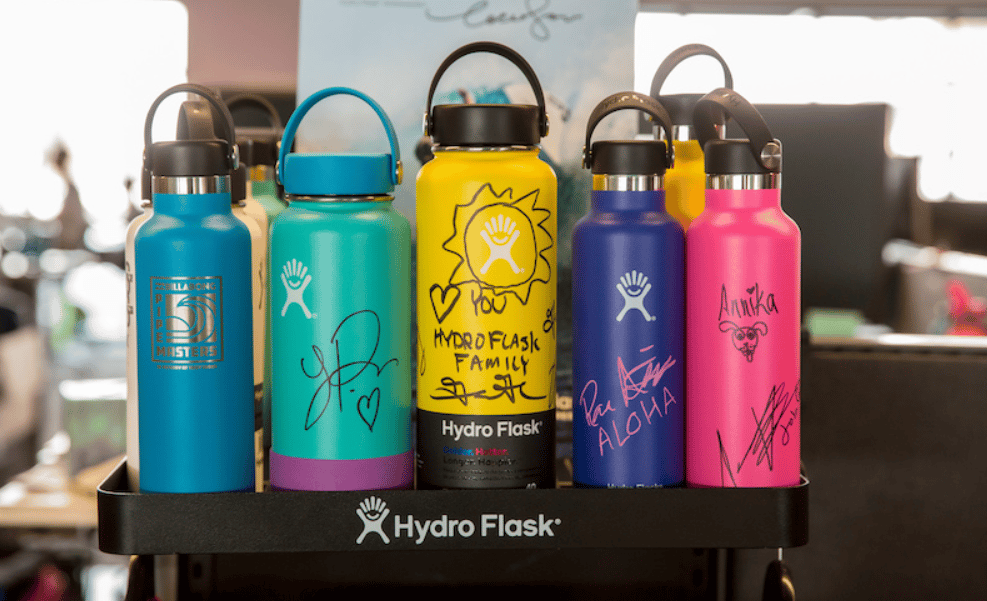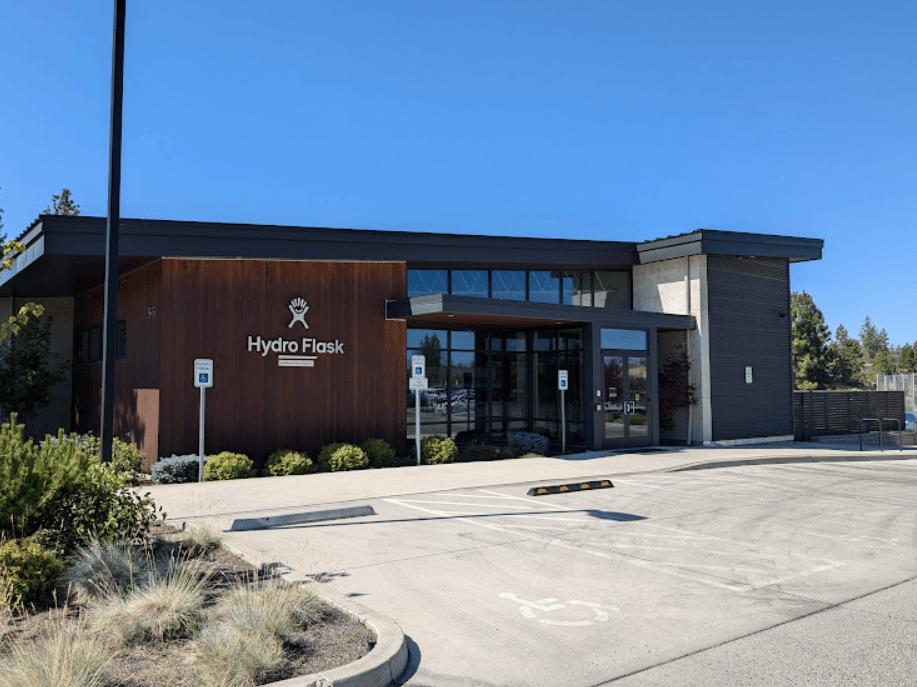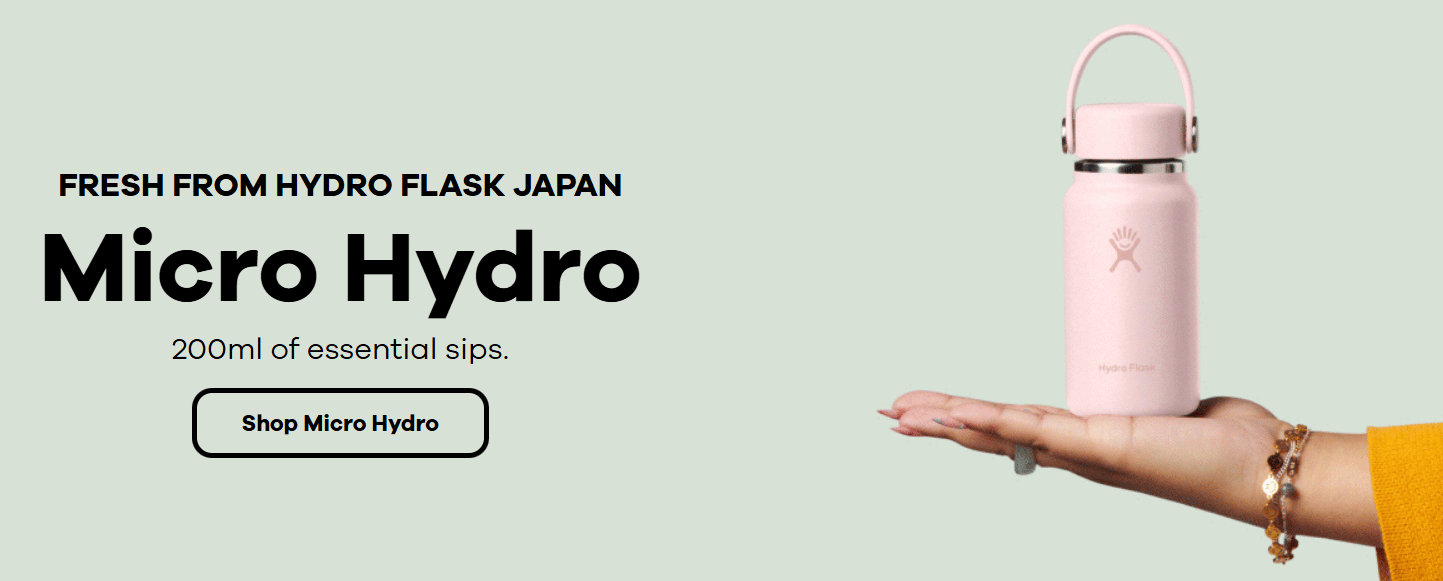- The Outdoors Crowd
- Posts
- Hydro Flask (2009), a deep-dive into the company's rise
Hydro Flask (2009), a deep-dive into the company's rise
Plus, social topics of the week and our pre-validation report structure.
Hey, Outdoors Crowd.
I hope you’re enjoying what’s left of the summer - wherever you’re reading from…
This week:
Social Listening - what’re the customers talking about?
Product Pre-validation Project - Proposed Structure
Hydro Flask - From a Couple in Bend to a $200M+ Global Icon
PS - if you’re new here or have been forwarded this email, you can read previous posts and sign up for the newsletter here: https://dereksdeepdive.beehiiv.com/
And please share if you like what we do. It helps enormously to drive down our cost or reader acquisition.
"Wilderness is not a luxury but a necessity of the human spirit" - Edward Abbey
What's Trending Now in Outdoors & Sports — Key Insights
1. Gen Z & Millennials Drive Outdoor Passion
Recent research reveals that 67% of young people identify as “outdoorsy” and a compelling 80% say they want to spend more time outside. These demographics are demanding brands to reflect values like sustainability, inclusivity, and authenticity.
Continuous
Implication: Marketing and product development must speak to value-first, lifestyle-driven younger consumers.
2. “Soft Adventure” is Out, “Luxury Function” Is In
WGSN’s top sports-and-outdoor trend for 2025 is “Soft Adventure”—experiences that are engaging yet still accessible and comforting. It sits in the broader push toward blending practicality with mood, emphasizing comfort and maintainable excitement.
ISPO.com – Welcome to the Home of Sports+4Instagram+4Boundless Network+4
Implication: Gear and event experiences should balance accessibility with aspirational storytelling.
3. Eco-Conscious Fashion and ‘Gorpcore’ Still Going Strong
The “Gorpcore” fashion trend—outdoor apparel styled for everyday wear—continues to dominate, especially among Gen Z and trend-minded consumers. Brands like Patagonia, Arc’teryx, and The North Face are gaining visibility not just for function, but for streetwear credibility.
Wikipedia+1
Implication: Outdoor brands remain powerful as lifestyle fashion, creating scope for hybrid street/outdoor collaborations and retail crossover.
4. Immersive Tech and Wearables Enter the Outdoor Playbook
New tech trends are shaping how people experience outdoor activities—from wearable sensors to AR/VR training tools and connected gear (IoT-enabled bikes, smart compasses, etc.). These innovations are helping brands redefine engagement and product utility.
reddit.com+9BBN Times+9Outdoor Industry Association+9
Implication: Early adopters of connected tech can differentiate their offerings and create enhanced user experiences in a crowded market.
Trend Snapshot
Trend | Data Insight | Strategic Insight for B2B Brands |
|---|---|---|
Youth engagement increases | 67% self-defined as outdoorsy; 80% want more time outdoors | Identify with younger values: sustainability, inclusion, style |
“Soft Adventure” aesthetic grows | Comfort-focused outdoor experiences trending | Blend functional design with approachable convenience |
Gorpcore fashion continues | Outdoor gear as streetwear keeps ascending | Build fashion-forward outdoor collections, collaborate creatively |
Immersive tech adoption | AR/VR, IoT, wearables rising in outdoor usage | Partner with tech innovators to add product and content depth |
Product pre-validation report - Sports and Outdoors
Launching with confidence in the outdoor industry is harder than ever. Too many great ideas never make it past prototype, while others hit the market only to miss the mark with consumers — costing brands time, money, and reputation.
That’s why we’re creating the Sports & Outdoor Gear Product Validation Report 2025 — an annual benchmark designed specifically for our industry. Built from a live jacket validation project and powered by real pre-launch data, this guide combines real-world case study insights, industry benchmarks, and practical tools to help you de-risk your next launch.
Here’s the proposed topline structure 👇
Coming Soon: The Sports & Outdoor Gear Product Validation Report 2025
De-risking product launches with real-world market data
Topline Structure:
Executive Summary – Key findings & takeaways.
The Market Reality – Why so many outdoor products fail.
The Validation Framework – Step-by-step methodology.
Case Study: Jacket Project 2025 – Live digital media results, insights & iteration lessons. Including price testing.
Industry Benchmarks – Conversion rates, pricing data & buyer insights.
Best Practices – Do’s, don’ts, and a go-to checklist for brands.
Tools & Templates – Practical resources you can use immediately.
Looking Ahead – Outdoor consumer trends for 2026.
Does this proposed structure appeal, and would it be of interest to you?Feel free to comment in the feedback. |
If you have anything you’d like to add, or update, please feel free to email me on [email protected] - all feedback is welcome, as this should be primarily a value add for you. Thanks.
Hydro Flask: From a Couple in Bend to a $200M+ Global Icon
Few outdoor brands have managed to straddle both core credibility and mainstream lifestyle success the way Hydro Flask has. In less than two decades, it went from an idea hatched by two entrepreneurs in Bend, Oregon, to a cultural phenomenon stocked in REI, Whole Foods, college campuses, and boardrooms alike.
For B2B readers in the industry, Hydro Flask is one of those rare cases where founder grit, clever positioning, and perfect timing met — followed by a smart acquisition and global scaling. It’s a story worth revisiting because it shows how the right product, in the right place, can jump the fence from outdoor specialty into full-blown consumer lifestyle.

Founders and the First Pour
Hydro Flask was founded in 2009 by Travis Rosbach and Cindy Weber, two entrepreneurs who had relocated to Bend, Oregon. At the time, Bend was emerging as a hub for craft beer, outdoor culture, and young professionals looking to mix lifestyle with work. Rosbach and Weber noticed a gap in the drinkware market: while stainless steel bottles existed, none were insulated in a way that kept drinks truly cold or hot for extended periods.
The couple began developing double-wall vacuum-insulated bottles, a technology used in thermoses but not widely applied to sleek, carry-everywhere bottles. Their pitch was simple but powerful: a water bottle that keeps cold drinks cold for 24 hours, and hot drinks hot for 12.
They launched Hydro Flask at Bend’s local farmers’ markets and outdoor events. Early adopters were hikers, bikers, and river rats — locals who immediately saw the utility of a bottle that worked for both coffee and post-paddle beers.

Building Momentum in Bend
Bend was the perfect launchpad. It had a strong outdoor identity, but also a brewing craft culture — breweries, yoga studios, climbing gyms. The bottles weren’t positioned as elite alpine gear; they were marketed as everyday companions for an outdoor lifestyle. That broadened the audience right from the start.
The founders built the business lean: word-of-mouth, grassroots events, and strategic placement in local outdoor shops. Within a few years, Hydro Flask bottles became recognizable on trails and in gyms, thanks to bold colors and the simple hydrogen atom logo.
The design mattered. Unlike utilitarian bottles of the time, Hydro Flask leaned into bright, matte finishes, ergonomic shapes, and wide mouths. It made hydration not just functional but fashionable. This was one of the brand’s early strokes of genius — treating the water bottle as a style item, not just a utility.
Scaling Up: Growth Years and Challenges
By the mid-2010s, Hydro Flask was on fire. Distribution spread across outdoor specialty retailers, yoga studios, and eventually big-box chains. Social media fueled the brand — not through polished campaigns, but through organic user love.
College students carried them everywhere. Athletes and yoga instructors promoted them without prompting. Instagram made the colorful bottles a lifestyle accessory. By 2016, Hydro Flask had become not just a bottle, but a status symbol.
The brand’s revenues reportedly crossed $50M annually by 2015 and kept accelerating. That year, Hydro Flask ranked #1 on Outside Magazine’s “Best Places to Work” list, highlighting not just product success but a vibrant internal culture.
But rapid growth created strain. Copycat competitors flooded in. Knockoff bottles on Amazon mimicked Hydro Flask’s design at half the price. Scaling manufacturing in Asia while preserving quality and protecting IP became a constant battle.

Acquisition by Helen of Troy
In March 2016, Hydro Flask was acquired by Helen of Troy Limited, a consumer goods company based in El Paso, Texas, with a portfolio spanning health, housewares, and beauty brands. The purchase price: $210 million in cash.
For Hydro Flask, this was a pivotal moment. The acquisition gave it access to Helen of Troy’s global distribution, supply chain expertise, and capital to fend off copycats and expand internationally. For Helen of Troy, it was a bet on outdoor lifestyle — a category with authentic growth at a time when many legacy consumer goods were stagnating.
Crucially, Hydro Flask’s leadership and culture were largely preserved. The brand remained headquartered in Bend, retaining its Pacific Northwest identity. That helped avoid the fate of some acquired brands that lose their soul after a buyout.

Analysis only - NEVER investment advice
After the Sale: Scaling Global
Post-acquisition, Hydro Flask went global. It launched aggressively in Europe, Asia, and Australia. The colorful bottles that had defined Bend and U.S. campuses began popping up on sidewalks in Tokyo and Berlin.
The brand expanded its product lines beyond bottles into tumblers, coffee flasks, soft coolers, lunch boxes, and accessories. It also doubled down on lifestyle marketing, sponsoring music festivals, surf events, and community initiatives.
At the same time, Hydro Flask leaned into environmental positioning, promoting reusability over single-use plastics. This messaging resonated with younger consumers and reinforced the brand as both functional and purposeful.
By 2019, Helen of Troy reported Hydro Flask revenues north of $200 million annually, making it one of the fastest-growing pieces of their portfolio. Even after COVID disruptions, the brand has remained resilient, with estimated revenues today still comfortably in the $150–200M range.
Cultural Impact
Hydro Flask’s cultural moment peaked around 2019–2020 with the rise of the “VSCO girl” trend on TikTok, where the bottle became a symbol of eco-conscious, youthful lifestyle. While some in the industry rolled their eyes, the association cemented Hydro Flask’s place in pop culture.
Unlike many gear brands that live only in specialty retail, Hydro Flask managed to cross into mainstream lifestyle while keeping outdoor credibility intact. You’ll see Hydro Flasks clipped to backpacks on the Pacific Crest Trail and tucked into tote bags in Manhattan offices. That duality is rare — and incredibly valuable.
Leadership and People
After the acquisition, Hydro Flask’s founders stepped away from day-to-day leadership. Today, the brand is overseen by Helen of Troy’s Housewares Division, which also manages OXO and Osprey Packs (another major outdoor acquisition made in 2021).
Hydro Flask continues to be operated out of Bend, where it employs a mix of product designers, marketers, and customer experience staff. The company is frequently lauded for its workplace culture, employee benefits, and connection to the community. Interesting, the parent is searching for a new CEO, after Noel Geoffroy stepped down in May. Brian Glass is interim CEO.

Revenue and Market Position
Today, Hydro Flask sits in an interesting spot in the industry:
Annual Revenues: ~$150–200M (Helen of Troy doesn’t break it out exactly, but segments show Hydro Flask as one of the strongest performers in their Housewares division).
Market Position: Hydro Flask dominates insulated drinkware in the outdoor specialty and lifestyle channel, competing with YETI, Stanley, and CamelBak.
Growth Channels: International expansion, new product categories, and DTC growth via its website and Amazon storefront.
For context, YETI is a $1.6B business and Stanley (thanks to its viral Quencher) is surging. Hydro Flask sits below those juggernauts, but comfortably above smaller specialty competitors.
Why Hydro Flask Matters for B2B Readers
Timing & Category Creation: Hydro Flask proved you can take an existing technology (vacuum insulation) and reframe it for everyday use. They didn’t invent, they repositioned — and built a category.
Distribution Strategy: They avoided the trap of staying in niche outdoor retail and went broad early — yoga studios, Whole Foods, lifestyle shops. That gave them reach that gear-only brands rarely achieve.
Acquisition Playbook: The 2016 sale to Helen of Troy shows how well-timed exits can protect a brand from knockoffs, fuel global growth, and preserve identity when handled thoughtfully.
Cultural Stickiness: By becoming a fashion accessory, Hydro Flask gained resilience. Even as competitors launched copycats, the brand retained its aspirational halo.
Scalability Lessons: For mid-sized outdoor brands today, Hydro Flask’s trajectory is a case study in how to punch above your weight and scale into lifestyle without losing roots.
The Road Ahead
Hydro Flask is now a mature brand. Growth isn’t the rocketship of 2015, but it remains steady. Future success likely depends on:
Category expansion: Soft goods (packs, coolers) could diversify revenue.
Environmental messaging: Tapping deeper into anti-single-use narratives.
Innovation in design: Competing with Stanley’s Quencher momentum by expanding form factors and targeting new demographics.
International growth: Europe and Asia are far from saturated and remain prime opportunities.
For B2B industry players, Hydro Flask is a reminder that sometimes, the simplest products can deliver the deepest disruption.

Bottom Line
From a farmer’s market in Bend to a $210M acquisition, Hydro Flask’s rise is one of the most remarkable outdoor brand growth stories of the past two decades. Founders Travis Rosbach and Cindy Weber spotted a gap, timed the cultural moment perfectly, and built a brand that jumped from trails to TikTok feeds.
Today, under Helen of Troy’s ownership, Hydro Flask is a $150–200M lifestyle powerhouse, balancing outdoor authenticity with mass appeal. For outdoor industry watchers, it’s a case study in timing, positioning, and scaling — proof that even a humble water bottle can change the shape of a category.
As usual, thanks for reading and I hope you find value in the newsletter. If you do, please share. It helps a lot. Also feel free to reach out directly with any thoughts or feedback (or interests in sponsoring / partnering) at [email protected]
Happy camping.
Until next week, go n-éirí leat!
Derek.
